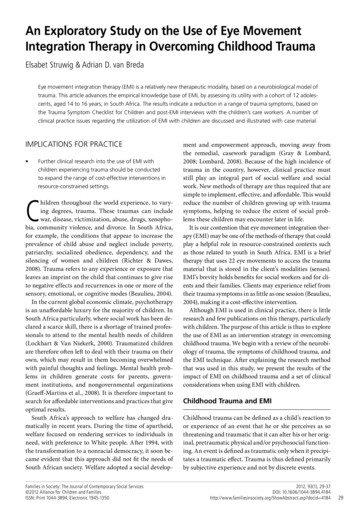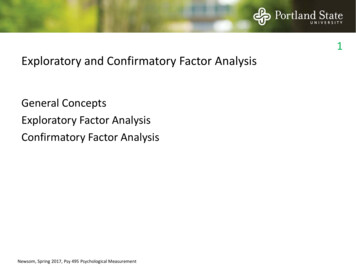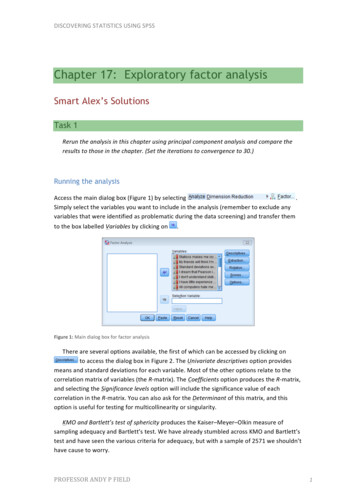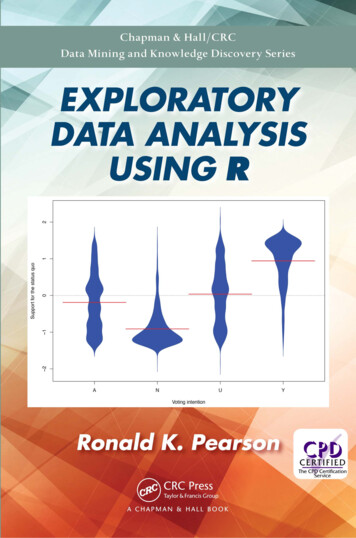
Transcription
An Exploratory Study on the Use of Eye MovementIntegration Therapy in Overcoming Childhood TraumaElsabet Struwig & Adrian D. van BredaEye movement integration therapy (EMI) is a relatively new therapeutic modality, based on a neurobiological model oftrauma. This article advances the empirical knowledge base of EMI, by assessing its utility with a cohort of 12 adolescents, aged 14 to 16 years, in South Africa. The results indicate a reduction in a range of trauma symptoms, based onthe Trauma Symptom Checklist for Children and post-EMI interviews with the children’s care workers. A number ofclinical practice issues regarding the utilization of EMI with children are discussed and illustrated with case material.Implications for Practice Further clinical research into the use of EMI withchildren experiencing trauma should be conductedto expand the range of cost-effective interventions inresource-constrained settings.Children throughout the world experience, to varying degrees, trauma. These traumas can includewar, disease, victimization, abuse, drugs, xenophobia, community violence, and divorce. In South Africa,for example, the conditions that appear to increase theprevalence of child abuse and neglect include poverty,patriarchy, socialized obedience, dependency, and thesilencing of women and children (Richter & Dawes,2008). Trauma refers to any experience or exposure thatleaves an imprint on the child that continues to give riseto negative effects and recurrences in one or more of thesensory, emotional, or cognitive modes (Beaulieu, 2004).In the current global economic climate, psychotherapyis an unaffordable luxury for the majority of children. InSouth Africa particularly, where social work has been declared a scarce skill, there is a shortage of trained professionals to attend to the mental health needs of children(Lockhart & Van Niekerk, 2000). Traumatized childrenare therefore often left to deal with their trauma on theirown, which may result in them becoming overwhelmedwith painful thoughts and feelings. Mental health problems in children generate costs for parents, government institutions, and nongovernmental organizations(Graeff-Martins et al., 2008). It is therefore important tosearch for affordable interventions and practices that giveoptimal results.South Africa’s approach to welfare has changed dramatically in recent years. During the time of apartheid,welfare focused on rendering services to individuals inneed, with preference to White people. After 1994, withthe transformation to a nonracial democracy, it soon became evident that this approach did not fit the needs ofSouth African society. Welfare adopted a social develop-Families in Society: The Journal of Contemporary Social Services 2012 Alliance for Children and FamiliesISSN: Print 1044-3894; Electronic 1945-1350ment and empowerment approach, moving away fromthe remedial, casework paradigm (Gray & Lombard,2008; Lombard, 2008). Because of the high incidence oftrauma in the country, however, clinical practice muststill play an integral part of social welfare and socialwork. New methods of therapy are thus required that aresimple to implement, effective, and affordable. This wouldreduce the number of children growing up with traumasymptoms, helping to reduce the extent of social problems these children may encounter later in life.It is our contention that eye movement integration therapy (EMI) may be one of the methods of therapy that couldplay a helpful role in resource-constrained contexts suchas those related to youth in South Africa. EMI is a brieftherapy that uses 22 eye movements to access the traumamaterial that is stored in the client’s modalities (senses).EMI’s brevity holds benefits for social workers and for clients and their families. Clients may experience relief fromtheir trauma symptoms in as little as one session (Beaulieu,2004), making it a cost-effective intervention.Although EMI is used in clinical practice, there is littleresearch and few publications on this therapy, particularlywith children. The purpose of this article is thus to explorethe use of EMI as an intervention strategy in overcomingchildhood trauma. We begin with a review of the neurobiology of trauma, the symptoms of childhood trauma, andthe EMI technique. After explaining the research methodthat was used in this study, we present the results of theimpact of EMI on childhood trauma and a set of clinicalconsiderations when using EMI with children.Childhood Trauma and EMIChildhood trauma can be defined as a child’s reaction toor experience of an event that he or she perceives as sothreatening and traumatic that it can alter his or her original, pretraumatic physical and/or psychosocial functioning. An event is defined as traumatic only when it precipitates a traumatic effect. Trauma is thus defined primarilyby subjective experience and not by discrete events.2012, 93(1), 29-37DOI: .org/ShowAbstract.asp?docid 418429
Families in Society Volume 93, No. 1Neurobiology of TraumaContemporary knowledge of neurobiology helps socialworkers to render community-based services to familiesthat are at risk from a holistic, biopsychosocial perspective (Shapiro & Applegate, 2000). The neurobiologicaleffects of trauma are important to understand becauseEMI is a neurotherapy that focuses on the integrationof trauma memories. The biological systems and neurotransmitters involved when a child is confronted witha threatening situation are multiple and complex (Briere& Scott, 2006).In brief, trauma follows a specific pathway in the brain(Solomon & Siegel, 2003). First, the information is received through the primary senses and the body. This information is sent to the locus ceruleus, which evaluates theinformation for threat content. The information is thenforwarded to the amygdala, where it is again evaluated foremotional content. The amygdala sends the informationto the hippocampus, which assigns cognitive meaning tothe information and routes it to the orbitofrontal cortex.The orbitofrontal cortex then activates the hypothalamicpituitary-adrenal (HPA) axis, which is the body’s endocrinal (hormonal) response. Important hormones, suchas cortisol and adrenaline, which are essential in stressresponse, are secreted. The information is also sent to thecerebral cortex, which organizes survival behavior.Two categories of memory play an important role inthe development of trauma memory (Inbinder, 2002;Rothschild, 2000; Van der Kolk, McFarlane, & Weisaeth,2007). First, explicit or declarative memory is the memory of facts, ideas, concepts, and events that individualsare consciously aware of and that are closely linked to thelanguage system. The hippocampus is responsible for processing explicit memory (Scaer, 2005). Because the hippocampus develops around the age of 2 or 3 years, peopledo not have explicit or declarative memories of theirearliest childhood experiences. Second, implicit or nondeclarative memory is stored in the amygdala, which ispresent from birth. Implicit memory bypasses language,has no narrative, and is unconscious. It can therefore bedescribed as “speechless” (Rothschild, 2000).Although these two memory systems are usually accurately coordinated, the hippocampus is vulnerable tostress (Teicher et al., 2003). If the amygdala is overstimulated, such as in the event of extreme stress, the functionof the hippocampus can be suppressed. The implicit andexplicit memories then become disengaged, leading to thedissociation of the sensory and affective elements fromany coherent narrative memories. This results in traumatic memory that is fragmented, out of sequence, andfull of gaps. These traumatic memories are saved withinthe modalities (senses). Even though the memories arefragmented, they continue to influence emotions and behaviors. Recovery from trauma requires the integrationof the explicit memories from the hippocampus with the30implicit memories of the amygdala (Beaulieu, 2004; Solomon & Siegel, 2003). This integration is the goal of EMI.Beaulieu (2004) held that although the association between eye movement and thought processing is generallyaccepted, it does not fully explain the neurological mechanisms of EMI. Beaulieu speculated that the effectivenessof EMI may be related to binocular rivalry and interhemispheric switching, smooth pursuit eye movements or thecorrelation between eye movements and sleep. Ultimately, the precise mechanism of EMI is still unknown. Ideally, there should be clear insight into the mechanisms oftherapies before they are implemented. However, there isin fact limited understanding of the mechanisms of manytherapies (Rajad, 2001) but social workers continue to usethem because they are effective. The mechanisms of EMIare, nevertheless, the subject of ongoing research.EMI, however, has a neurological component that normal talk therapies do not have. Beaulieu (2004) explainedthis by a metaphor of three glasses filled with chlorine,representing the trauma symptoms. The glasses representthe cognitive, sensory, and emotional modes of the person. If water (representing the therapy) were added to oneof the glasses, the other two would be untouched. Normaltalk therapy does not reach all three modes involved insituations of extreme stress. EMI, by contrast, focuses onthe trauma event itself, eliciting and addressing the material across all three modes.Symptoms of Childhood TraumaChildren who experience trauma present with varioussymptoms. The severity, intensity, and number of different traumas predict the severity of these symptoms(Briere, Kaltman, & Green, 2008). The Trauma SymptomChecklist for Children (TSCC) measures the presenceand intensity of six different symptom domains, namely,anger, anxiety, depression, sexual concerns, posttraumatic stress, and dissociation (Briere, 1996). As the TSCC isthe quantitative instrument we used for this study, thesesix symptoms of trauma will be briefly discussed.Anger. The anger and rage of a traumatized child canbe quite severe. Anger can be a normal way of releasingenergy, after which the event that triggered it can be explored in a calmer state. Children can turn their angereither inwards (e.g., self-mutilation) or outwards (e.g.,inappropriate and apparently unprovoked rage; Evertt &Gallop, 2000).Anxiety. Anxiety is both a symptom of trauma and anindicator of the presence of trauma symptoms. Childrenwith preexisting anxiety are more susceptible to developing posttraumatic symptoms, and traumatized childrenmay meet the criteria for other anxiety disorders (Fong &Garralda, 2005).Depression. Depression is a well-known symptom oftrauma. It has been positively linked to child maltreatment (Corby, 2006), but is especially a risk factor when
Struwig & van Breda An Exploratory Study on the Use of Eye Movement Integration Therapy in Overcoming Childhood Traumathe child has been violently injured (Pailler, Kassam-Adams, Datner, & Fein, 2007). There is also evidence thatadolescents who experience depression after trauma mayengage in risky behavior such as alcohol abuse and suicide attempts. In younger children, depression typicallymanifests as aggression, rage, and anxiety (Kagan, 2004).Sexual concerns. Children who have been sexuallyabused, raped, or exploited may experience either sexualpreoccupation or sexual distress (Briere, 1996). The childmay associate sexual activity with good things, such aspersonal attention, and therefore engage in hypersexualbehavior. Alternatively, the child may associate her or hissexuality with negative feelings and memories, resulting inavoidance of sexuality (Wieland, 1998). Sexual abuse mayhave been a physically painful experience for the child,causing feelings of distress associated with sexuality.Posttraumatic stress. Posttraumatic stress (PTS) encompasses a collection of thoughts, feelings, reactions,and behaviors that follow the experience of a distressingincident that is usually outside the normal range of human experience. The symptoms of PTS can occur days,months, or even years after an incident. PTS is diagnosedwhen indicators of reexperiencing, numbing and avoidance, and excessive arousal are present (Vasterling &Brewin, 2005).Dissociation. Dissociation is a defense mechanism inwhich a person experiences a feeling of detachment froma traumatic situation, often resulting in a distortion oftime and perception. According to the theory of structural dissociation, the apparently normal personality (ANP)is described as the part of the personality involved in thedaily management of life. It helps a person to functionnormally (i.e., as before the traumatic experience and inaccordance with social expectations). ANP is associatedwith partial or complete amnesia, avoidance of the traumatic memories, or numbing. The emotional personality(EP) is the part of the personality that is stuck in the traumatic memory that fails to integrate with the narrativememory of the experience. It therefore responds to perceived threats while trapped in the past traumatic experience (Van der Hart, Nijenhuis, & Steele, 2006).These six trauma-related symptoms do not encompassthe whole impact of a traumatic experience, but they canhelp social workers to formulate a useful interventionplan. EMI is a method of intervention that addresses allof these symptoms by integrating the fragmented trauma memories.Application of EMIEMI has its roots in neurolinguistic programming. Steveand Connirae Andreas explored the possibility that eyemovements might influence thought, given that it seemedthat thought influenced eye movements, and they subsequently developed EMI. Beaulieu, who studied underthe Andreases, developed the technique further. The EMIprotocol we used is discussed fully by Beaulieu (2004)and will be only briefly described here. Proper training inEMI is required for ethical practice.Assessment. Before starting an EMI session, it is important to conduct a full clinical assessment. In our clinical experience, however, clients frequently process someof their trauma in the interval between assessment andthe initiation of therapy. Therefore, for the purpose ofthis study, the therapy was conducted on the same dayas the brief assessment, to reduce the potential therapeutic value of the assessment. The social worker evaluateswhether the child is a suitable candidate for EMI, considering various psychological and physical conditions.For example, people with eye problems, high levels ofdistress, or neurological conditions such as epilepsy areusually contraindicated for EMI. On the other hand, EMIis indicated as a treatment option for chronic but not foracute trauma symptoms (Beaulieu, 2004), and at least 4to 6 weeks must have passed since the traumatic incident.Preparation. After determining whether the child is asuitable candidate for EMI, the clinician starts with thepreparation phase by explaining the EMI process. In thisstudy the clinician (the first author) used the followinganalogy of chlorine and water to explain how EMI works:“Trauma is a bit like chlorine. If you drink concentratedchlorine, you will become very sick and may even die.When diluted in a swimming pool, however, chlorineis harmless. In the same way, EMI dilutes trauma—thetrauma will always be part of your life, but will not bepoisonous anymore.”After clarifying these concepts, the social worker andchild together identify the principal knot of the traumaticevent. The knot is the part of the event that the child findsthe most traumatic. From this knot, keywords or phrases,known as verbal cues, are selected to help the child stay intouch with the event. The main criterion for identifyingthe verbal cues is that they must capture the essence ofthe principle knot and remind the child of the traumaticevent. For example, one of the participants in this studywitnessed the murder of a significant person in her life.The principal knot for her was that this person was murdered, decapitated, and just left on the floor on a blackrefuse bag. Her verbal cues were, “The night that R wasmurdered. She’s lying on a black bag.”After verbal cues are chosen, the social worker determines the visual range of the client, as well as the speedof the eye movements. The visual range can be describedas the frame within which a person’s eyes can comfortably follow the EMI hand movements. A focal point isalso created either by holding a brightly colored objector by using the index and middle fingers. This helps theclient follow the eye movements, thus entering all theareas of the visual range. The distance of the focal pointfrom the eyes is established to ensure comfort duringthe movements.31
Families in Society Volume 93, No. 1The next step is to determine the areas in the visualrange that elicit the least and most emotional discomfort. In EMI, areas that elicit discomfort are referred toas visual hotspots, while the area that calms is called abeneficial quadrant. The social worker identifies hotspotsand beneficial areas by moving the open hand across thevisual range while repeating the verbal cues. During thisprocedure, the worker asks the client to communicatetheir level of distress or comfort. It is often the case thata client finds certain areas particularly beneficial or distressing. The social worker can also observe physical responses that indicate discomfort, such as backing away.The child who witnessed the murder, for example, couldphysically hear the victim’s screams and covered her earswhen the movements entered the bottom left quadrant orcorner of the visual frame.Implementation. After these preparations, the socialworker starts the therapy, with the 22 eye movements ofEMI, to facilitate access to traumatic material in differentsensory modalities (Beaulieu, 2004). The eye movementsor segments cover at least two areas in the visual field, forexample, from the top left corner to the top right corner.The EMI protocol stipulates the number, duration, andrhythm of the movements. However, the application of themovements is flexible and can be modified to fit the needsof the client. The client can also be asked if they want anyother kind of patterns to be used during the therapy. During the eye movement segments, the social worker gathersinformation about the child’s experience. Information elicited from modalities must be explored. The memory of anyevent or situation is encoded and stored in all the senses tosome extent. The social worker would therefore ask, “Didyou see any pictures? Or maybe smell or hear anything?”It is important to be attentive to the client’s facial expressions and body language. For example, one respondentturned her head or covered her ears when she could hearthe screaming of the murder victim during the eye movements. The therapist can use this as a cue to explore thatspecific modality. It is important, however, to keep in mindthat EMI is not so much a psychotherapy as it is a neurotherapy. Therefore, the therapist must refrain from spending too much time on eliciting information.After repeating the eye movement segments, the social worker may notice that the pictures the client seeshave changed. For example, different areas of the visualrange brought the participant who witnessed a murderinto contact with various pictures about the night of themurder. At first she saw herself as the victim in a pinknightgown, lying on a black plastic bag. She also saw themurderers driving off in a white motor vehicle, as well asthe paramedics lifting the body into the ambulance. Sheeven saw the shadows of the murderers behind the garagedoor. After EMI therapy, her picture changed—she sawthe murder victim, sitting on a bed, smiling and readingher a story. A physical response of relief was noticeable.32These changed pictures are an indication that integrationof the trauma material has taken place, in other words,that the implicit and explicit memories (from the amygdala and hippocampus, respectively) have been reconnected and integrated.Closure. After the integration, the session is closed andthe social worker can spend time answering questionsand explaining what to expect after the session. The clinician prepared the children during the study for the physical symptoms they might experience, such as headachesand nausea.MethodologyThe goal of this study was to explore the use of EMI asa social work intervention for treating psychosocialtrauma with adolescents aged 14 to 16 years. In orderto achieve our goal, we adopted an exploratory, mixedmethods design. This approach is appropriate given thelack of literature on the use of EMI with children and thetentative nature of our research question (Royse, 2008).Our approach was simultaneously to collect preliminaryevidence on the effectiveness of EMI in reducing traumaand monitor the clinical implications of using EMI withadolescents. We mixed our methods in order to obtaina richer set of data and to raise the trustworthiness andrigor of our study (Brannen, 2005).We defined the population as children aged 14 to 16years who had experienced trauma and who presentedwith current symptoms of trauma that had been presentfor at least 4 weeks prior to baseline data collection. Inaddition, we included the guardian of each child, therebystudying child–guardian pairs. Using quota sampling, weselected 12 children from a local children’s home, using atwo-by-two sampling frame to obtain equal representation of boys and girls, Black and White. We consideredthis small sample to be sufficient given the exploratorynature of the study.The ethical protection of the children was ensuredthrough a number of mechanisms. For example, the children’s home has on-site social workers who were available to provide follow-up therapy to children if required.We ensured that the children were stable and suited forEMI through in-depth discussions with each child’s social worker during the recruitment phase. The clinicianalso remained in regular contact with Beaulieu duringthe data collection phase. Ethical approval for the studywas obtained from the University of Johannesburg’s Ethics Committee.The clinician approached the children’s legal guardians to obtain informed consent to participate in thestudy and subsequently approached the children to obtain their assent to participate. Each child participated ina single session of EMI. Although EMI should ordinarilybe integrated into a holistic clinical relationship, for the
Struwig & van Breda An Exploratory Study on the Use of Eye Movement Integration Therapy in Overcoming Childhood TraumaTable 1. Results of the Pre-EMI and Post-EMI atic stressDissociationSexual concernsPre-EMI median585951605467Post-EMI median484545445048Negative ranks§111191299Z 2.83 2.99 1.38 3.07 2.06 Indication of the number of participants who evidenced a decrease in each trauma symptom.* Improvement significance p .05.§purposes of this study, we chose to isolate EMI from theclinical process.A pretest/posttest design was used to generate preliminary evidence of EMI’s effectiveness with this population. Immediately before the EMI session, and 2 weeksafter the session, each child completed the TSCC (Briere,1996), which is a frequently used instrument to determine the presence and intensity of trauma symptomsamong children and adolescents (Elhai, Gray, Kashdan,& Franklin, 2005). The TSCC is a 54-item self-report scalethat can be used with both boys and girls in the age range8–16 years. The TSCC measures six constructs: anxiety,depression, anger, posttraumatic stress, dissociation, andsexual concerns. Responses are rated on a 4-point scale,from 0 (never) to 3 (almost all the time). The TSCC hasdemonstrated good validity and reliability in a numberof studies (e.g., Briere, 1996; Nilsson, Wadsby, & Svedin,2008; Sadowski & Friedrich, 2000). The TSCC has not,however, been standardized in South Africa.In addition to the TSCC, the clinician interviewed thechildren’s care workers 2 weeks after the EMI session, toexplore changes in the child’s behavior following EMI.These interviews were conducted using a semistructuredinterview schedule, designed to explore the same traumasymptoms that were measured by the TSCC, so as to triangulate the results.Finally, the clinician kept a journal concerning theexperience of implementing EMI. Journaling is an important method in critically reflective research (Jasper,2005). The journal was used to keep a record of the clinician’s observations of the therapy, speculations about theresponses of the children, and thoughts about possibleshortcomings and advantages of the EMI method withthis population. Comments made by the participantsduring and after EMI were recorded in the journal.We analyzed the TSCC using the Wilcoxon SignedRank Test, a nonparametric test of difference betweenpairs of data (in this case, the 12 pairs of pre- and postEMI data; Pett, 1997). We analyzed the qualitativedata using content analysis procedures (Ezzy, 2002).Throughout the analysis, we kept the three sets of dataclose together to facilitate the dialogue between themultiple methods.FindingsImpact of EMI on Trauma SymptomsWe had not expected to find significant differences between the pre- and posttest data, because of the verysmall sample size. Nevertheless, Table 1 indicates significant changes in all but one of the TSCC subscales. Avisual inspection of the pre-EMI and post-EMI medianscores shows a decrease in all scores, indicative of reduced trauma symptoms. It would appear, therefore, thatthere is preliminary evidence for the effectiveness of EMIas a therapeutic intervention for the resolution of childhood trauma symptoms among adolescents aged 14–16.Anxiety. The TSCC recorded a significant decrease inanxiety. Six of the care workers indicated an observablereduction in the anxiety of their children following EMItherapy. One child reported a reduction in feelings ofanxiety and another said she was sleeping better. A thirdchild, whose care worker reported as experiencing extreme anxiety prior to the EMI therapy, experienced mildchest pains during the EMI session and a mild headacheimmediately after the session—Beaulieu (2004) indicatesthat such reactions are common. The following day, however, this child experienced a marked reduction of anxiety and 2 weeks later reported an inexplicable feeling of“lightness” and relief.Depression. A significant reduction in depression wasmeasured by the TSCC. Eight of the care workers reported that they noticed a decrease in depressive symptomsafter the EMI therapy. One care worker reported that before EMI, her child had insomnia, wandered around thehouse at night, and isolated himself in his room. Following EMI, however, he began to sleep through the nightand to talk more about his trauma. Another care workerreported that before EMI, her child cried frequently.When going for therapy, she would cry for the entire session, unable to speak a word. Following the EMI session,however, she seemed more contained and had shown nobouts of crying.Anger. Although the TSCC scores for anger decreasedfrom pre-EMI (Mdn 51) to post-EMI (Mdn 45), theseresults were not statistically significant. Seven of the careworkers described the children in their care as not being33
Families in Society Volume 93, No. 1angry either before or after EMI, which could account forthe muted TSCC results. Two of the children were angry onthe follow-up day—one related to a school incident and theother because his iPod was stolen—which could accountfor their elevated post-EMI anger scores. Two care workers, who described their children as having anger outburstsprior to the study, reported that there had been no outbursts since the EMI. These results are thus inconclusive.Posttraumatic stress. The TSCC scores for PTS decreased for all 12 children, resulting in an overall significant reduction. Six care workers reported a noticeable reduction in PTS after EMI. One child, who suffered fromregular nightmares and who reported having a nightmarethe night before EMI, reported no subsequent nightmares.She had also never completed a therapeutic process before,because of her avoidance of her traumatic experiences, butshe did complete the EMI session. Another child describedher flashbacks as “movies” in her head. Prior to EMI, shewas afraid to sleep because of vivid nightmares. She wouldtry to stay awake as long as possible or sleep in the livingroom. After EMI she slept in her own bed, although withthe light on because she was still afraid of the dark. She reported experiencing fewer “movies” during the day, whichhelped her cope with school.Dissociation. The TSCC score for dissociation decreased significantly. Care workers had difficulty reporting on changes in dissociation, because the signs aresubtle. One child reported that before EMI she saw “deadpeople” and “ghosts.” The care worker reported thatfollowing EMI these sightings decreased significantly,which also contributed to the child’s improved sleepingpatterns. The child reported seeing her dead grandmother only once after EMI. Another care worker mentionedthat she avoided excessive contact with her child, because she was scared of his strange behavior. This childreported that prior to EMI he had a small man sitting onhis shoulder—he said they were friends, and he avoidedcontact with his peer group because they interfered withhis fantasy play. Although he still reported a high levelof daydreaming after EMI and continued talking to theman on his shoulder, there was a decrease in dissociativesymptoms according to the TSCC.Sexual concerns. The TSCC subscale for sexual concerns decreased significantly after EMI. One of thechildren mentioned that after EMI, while she was stillanxious when around boys, she found it less stressful tointeract with them. Another child was in a specializedhouse for sexualized girls, as she presented with sev
Integration Therapy in Overcoming Childhood Trauma elsabet struwig & adrian D. van Breda eye movement integration therapy (emi) is a relatively new therapeutic modality, based on a neurobiological model of trauma. this article advances the empirical knowledge base of emi, by assessing its utility with a cohort of 12 adoles-











